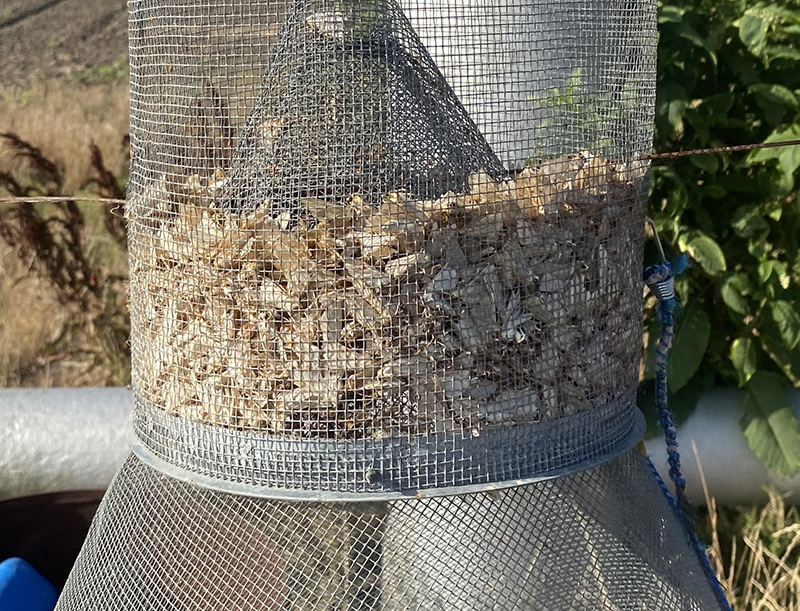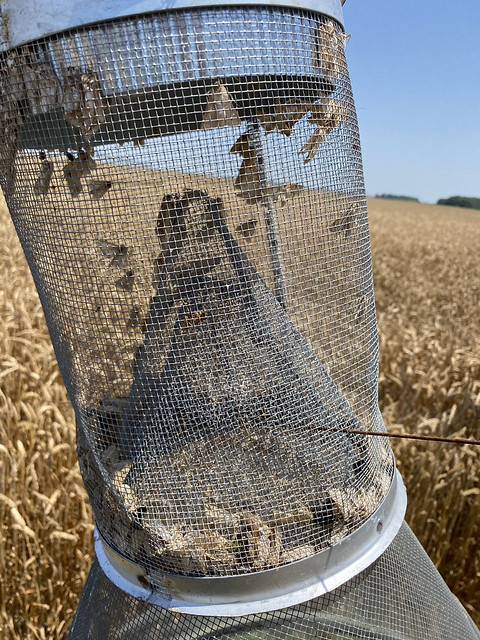Bollworm numbers up compared to 2021; farmers urged to scout
“These bollworm numbers have exploded it seems in the past two or three weeks,” said John David Farabough, Desha County extension agent for the University of Arkansas System Division of Agriculture. “I have traps spread from north to south borders in Desha County and all are running high numbers for this time of year.”
July 1, 2022
By Mary Hightower
U of A System Division of Agriculture
Fast facts
- Some areas seeing 2,000 bollworms per seven-day catch
- Soybean, grain sorghum, cotton farmers need to scout
- 2022 County Trap Catches
(368 words)
(Newsrooms: with art https://flic.kr/s/aHBqjzWvBh )
KEISER, Ark. — If there was one phrase to sum up farming in Arkansas at the start of summer, it would be “keep scouting.”
Surveillance done by Cooperative Extension Service county agents around the state has found bollworm numbers up compared to 2021. Each year, agents post traps, and each month, they count the trapped insects as an indicator of what pests local farmers might expect to see in their fields.

Hungry bollworms can damage soybean pods, corn ears and cotton bolls and squares.
“These bollworm numbers have exploded it seems in the past two or three weeks,” said John David Farabough, Desha County extension agent for the University of Arkansas System Division of Agriculture. “I have traps spread from north to south borders in Desha County and all are running high numbers for this time of year.”
“Normally, at this time of year, I'm running 100 to 200 moths per trap per week,” he said. Now, “weekly trap counts are running 500 to 800 moths per trap per week.”
Farabough said he typically doesn’t see these numbers until late July or early August “when the corn in the area is drying out and then moths move into soybeans.”
Pretty big flight
“We are experiencing a pretty big bollworm flight. It does appear to be higher trap catches than what we were seeing at this time last year,” said Glenn Studebaker, extension entomologist and integrated pest management coordinator for the Division of Agriculture.
“We are seeing them primarily in soybean and grain sorghum right now, but I expect we will begin to see significant populations in cotton as well,” he said. “Growers need to be diligent in scouting susceptible crops for bollworm at this time.”
Studebaker said some areas are seeing more than 2,000 moths per seven-day catch.
“Reports are coming in of bollworm being found in flowering soybeans,” he said. “Some are picking up six to eight worms per 25 sweep sample in R2 soybeans.”
R2 is a reproductive stage at which soybeans are in full flower.
“Growers are encouraged to keep watch for bollworm larvae in susceptible crops such as soybean, grain sorghum or cotton,” Studebaker said. “It is likely with such high moth catches that we will see increased numbers in these crops.”
To learn more about Division of Agriculture research, visit the Arkansas Agricultural Experiment Station website: https://aaes.uada.edu. Follow on Twitter at @ArkAgResearch. To learn more about the Division of Agriculture, visit https://uada.edu/. Follow us on Twitter at @AgInArk. To learn about extension programs in Arkansas, contact your local Cooperative Extension Service agent or visit www.uaex.uada.edu.
About the Division of Agriculture
The University of Arkansas System Division of Agriculture’s mission is to strengthen agriculture, communities, and families by connecting trusted research to the adoption of best practices. Through the Agricultural Experiment Station and the Cooperative Extension Service, the Division of Agriculture conducts research and extension work within the nation’s historic land grant education system.
The Division of Agriculture is one of 20 entities within the University of Arkansas System. It has offices in all 75 counties in Arkansas and faculty on five system campuses.
Pursuant to 7 CFR § 15.3, the University of Arkansas System Division of Agriculture offers all its Extension and Research programs and services (including employment) without regard to race, color, sex, national origin, religion, age, disability, marital or veteran status, genetic information, sexual preference, pregnancy or any other legally protected status, and is an equal opportunity institution.
# # #
Media contact: Mary Hightower
mhightower@uada.edu
